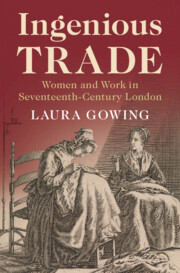Book contents
- Ingenious Trade
- Ingenious Trade
- Copyright page
- Contents
- Figures
- Tables
- Acknowledgements
- Introduction
- 1 Bred in the Exchange: Seamstresses and Shopkeepers
- 2 Girls as Apprentices
- 3 Managing the Trade: Women as Mistresses
- 4 What Girls Learned
- 5 Making Havoc: Discipline, Demeanour and Resistance
- 6 Freedoms and Customs
- Conclusion
- Appendix Who’s Who
- Bibliography
- Index
6 - Freedoms and Customs
Published online by Cambridge University Press: 29 November 2021
- Ingenious Trade
- Ingenious Trade
- Copyright page
- Contents
- Figures
- Tables
- Acknowledgements
- Introduction
- 1 Bred in the Exchange: Seamstresses and Shopkeepers
- 2 Girls as Apprentices
- 3 Managing the Trade: Women as Mistresses
- 4 What Girls Learned
- 5 Making Havoc: Discipline, Demeanour and Resistance
- 6 Freedoms and Customs
- Conclusion
- Appendix Who’s Who
- Bibliography
- Index
Summary
Chapter 6 looks at the long afterlife of apprenticeship, examining women’s claims to become free and the ways in which they met, and did not meet, the demands of City custom. As with indentures, the paperwork of petitions shows marriage undercutting women’s entitlements; a maze of customary rights blocked women from enjoying the freedom unconditionally. At the same time, in practice the City accepted humble petitions, took fees and granted ‘small shops’ to women who could prove their connections to companies. Women’s place in the City was significant and rooted in tradition and daily practice, but contingent.
- Type
- Chapter
- Information
- Ingenious TradeWomen and Work in Seventeenth-Century London, pp. 209 - 242Publisher: Cambridge University PressPrint publication year: 2021

